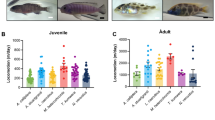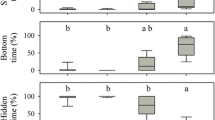Abstract
Locomotor activity rhythm in the hypogean population of Nemacheilus evezardi was recorded first under light-to-dark (LD) 12 : 12 h cycle and then DD. The results were compared with that of its epigean counterpart held under comparable regimes. In LD 12 : 12, while hypogean loach exhibited a distinct bimodality in its locomotor activity rhythm, it was altogether absent in the case of epigean population. In hypogean loach, dark-to-light transition peak in LD was observed to free-run under DD. The same was not discernible in case of epigean loach. The locomotor activity rhythm in epigean fish was noticed to free-run in DD either from the dawn peak or dusk peak in LD. It is hypothesized that the hypogean fish still possesses a functional oscillator underlying its overt circadian rhythm in locomotor activity. The ecophysiological significance of these findings is yet to be fully understood.
Similar content being viewed by others
References
Adbel Latif, H., E.S. Hassan & C. von Campenhausen. 1990. Sensory performance of blind Mexican cave fish after destruction of the canal neuromasts. Naturwiss. 77: 237–239.
Behrens, M., T.G. Langecker, H. Wilkens & H. Schmale. 1997. Comparative analysis Pax-6 sequence & expression in the eye development of the blind cave fish Astyanax fasciatus and its epigean conspecific. Mol. Biol. Evol. 14: 299–308.
Biswas, J. 1990. Biospeleology: the behavioural and physiologic adaptations in a cavernicole. Ph.D. Thesis, Pandit Ravishankar Shukla University, Raipur. 136 pp.
Biswas, J. 1993. Kotumsar Cave ecosystem: an interaction between geophysical, chemical, and biological characteristics. Nat. Speleol. Soc. Bull. 54: 7–10.
Biswas, J. 1994. Effects of different light intensities on phototactic responses of a hill-stream loach, Lepidocephalus guntea (Ham.): a chronobiological approach. Proc. Indian Nat. Sci. Acad. 60B: 107–114.
Biswas, J., A.K. Pati & R.K. Pradhan. 1990a. Circadian and circannual rhythms in air-gulping behavior of cave fish. J. Interdisc. Cycle Res. 21: 257–268.
Biswas, J., R.K. Pradhan & A.K. Pati. 1990b. Studies on burying behavior in epigean and hypogean fish, Oreonectus evezardi: an example of behavioral divergence. Mem. Biospeleol. 17: 33–41.
Brown, F.A. 1961. Diurnal rhythm in cave crayfish. Nature 191: 929–930.
Cordiner, S. & E. Morgan. 1991. Endogenous locomotor activity patterns in the blind Mexican cave fish Astyanax mexicanus. J. Interdisc. Cycle Res. 22: 103.
De Prins, J., G. Corn´elissen & W. Malbecq. 1986. Statistical procedures in chronobiology and chronopharmacology. Annu. Rev. Chronopharmacol. 2: 27–141.
Erckens, W. & W. Martin. 1982. Exogenous and endogenous control of swimming activity in Astyanax mexicanus (Characidae, Pisces) by direct light response and by a circadian oscillator. II. Features of time controlled behavior of a cave population and their comparison to a epigean ancestral form. Z. Naturforsch. Sect. C, Biosci. 37: 1266–1273.
Eriksson, L.O. 1975. Diel and annual locomotor activity rhythms in some fresh water fish species with special reference to the seasonal inversion in salmonids. Ph.D. Thesis, University of Umeå, Umeå. 178 pp.
Eriksson, L.O. & T. van Veen. 1980. Circadian rhythms in the brown bullhead, Ictalurus nebulosus (Teleostei). Evidence for an endogenous rhythm in feeding, locomotor, and reaction time behavior. Can. J. Zool. 58: 1899–1907.
Gibson, R.N. 1971. Factors affecting the rhythmic activity of Blennius pholis L. (Teleostei). Anim. Behav. 19: 336–343.
Helfman, G.S. 1986. Diel distribution and activity of American eels (Anguilla rostrata) in a cave-spring. Can. J. Fish Aquat. Sci. 43: 1595–1605.
Hüppop, K. 1986. Oxygen consumption of Astyanax fasciatus (Characidae, Pisces): a comparison of epigean and hypogean populations. Env. Biol. Fish. 17: 299–308.
Hüppop, K. 1989. Genetic analysis of oxygen consumption rate in cave and surface fish of Astyanax fasciatus (Characidae, Pisces): further support for the netural mutation theory. Mem. Biospeleol. 16: 163–168.
Mitchell, R.W., W.H. Russell & W.E. Elliott. 1977. Mexican eyeless characin fishes, genus Astyanax: environment, distribution and evolution. Sp. Publ. Mus. Texas Tech. Univ. 12: 3–89.
Motohashi, Y., A. Reinberg, F. Lévi, J. Nouguier, O. Benoit, J. Foret & P. Bourdeleau. 1987. Axillary temperature: a circadian marker rhythm for shift workers. Ergonomics 30: 1235–1247.
Nelson, W., Y.L. Tong, J.K. Lee & F. Halberg. 1979. Methods for cosinor rhythmometry. Chronobiologia 6: 305–323.
Pati, A.K., S. Gupta & R. Maheshwari. 1998. Optoelectronic device, a useful tool to record surfacing behavior in airbreathing fishes. Curr. Sci. 74: 146–149.
Peters, N., V. Schacht, W. Schmidt & H. Wilkens. 1993. Cerebral proportions and degree of development of sense organs in Astyanax mexicanus (Pisces, Characinidae) comparison between river fish and its cave-living forms anoptichthys. Zeit. Zool. Syst. Evol. 31: 144–159.
Pradhan, R.K. 1984. Biochemical studies of some tissues of Nemacheilus evezardi Day from Kotumsar Cave. Ph.D. Thesis, Pt. Ravishankar Shukla University, Raipur. 195 pp.
Pradhan, R.K. & J. Biswas. 1994. Towards regressive evolution: the periodic color change behavior of a troglophilic fish, Nemacheilus evezardi (Day). Int. J. Speleol. 23: 191–201.
Pradhan, R.K., A.K. Pati & S.M. Agarwal. 1989. Meal scheduling modulation of circadian rhythm of phototactic behavior in cave dwelling fish. Chronobiol. Int. 6: 245–249.
Reichle, D.E., J.D. Palmer & O. Park. 1965. Persistent rhythmic locomotor activity in the cave cricket, Hadenoecus subterraneus, and its ecological significance. Amer. Midl. Nat. 74: 57–66.
Riedel, G. & L. Krug. 1997. The forebrain of the blind cave fish Astyanax hubbsi (Characidae). II. Projections of the olfactory bulb. Brain Behav. Evol. 49: 39–52.
Schwassmann, H.O. 1971. Biological rhythms. pp. 371–428. In: W.S. Hoar & D.J. Randall (ed.) Fish Physiology, Vol. 6, Academic Press, New York.
Teyke, T. & S. Schaerer. 1994. Blind Mexican cave fish Astyanax hubbsi respond to moving visual stimuli. J. Expt. Biol. 188: 89–101.
Wilkens, H., T.G. Langecker & J. Olcese. 1993. Circadian rhythms of melatonin synthesis in the pineal organ of cavedwelling Astyanax fasciatus (Teleostei: Characidae). Mem. Biospeleol. 20: 279–282.
Zafar, N.P. & E. Morgan. 1992. Feeding entrains an endogenous rhythm of swimming activity in the blind mexican cave fish. J. Interdisc. Cycle Res. 23: 165–166.
Author information
Authors and Affiliations
Rights and permissions
About this article
Cite this article
Kumar Pati, A. Temporal Organization in Locomotor Activity of the Hypogean Loach, Nemacheilus Evezardi, and its Epigean Ancestor. Environmental Biology of Fishes 62, 119–129 (2001). https://doi.org/10.1023/A:1011804020490
Issue Date:
DOI: https://doi.org/10.1023/A:1011804020490




